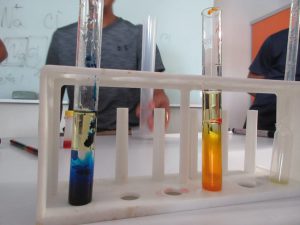As we learned before, all matters are made of different atoms and chemical elements. During the round 2 session, I have studied about Covalent Bond and Ionic Bond which are the combination of elements chemically as well as lessons about the elements in the periodic table. The atoms that are combined together to make different structures including molecules, crystals, etc; are joined together by the force of attraction from the chemical bond. The attraction is made when atoms share or transfer electrons. The electrons that can be shared or transfer are called the Valence Electrons which are located in the outer energy of an atom.
Ionic Bond: Some atoms share their valence electrons, but some atoms transfer their valence electrons from one atom to another. Ionic Bond is the transfer of valence electron from metallic ions to non-metal ions. Usually, the metallic ions give away their valence electrons to become positively charged and non-metals gain valence electrons to become negatively charged. Ionic Bonding creates Ionic compounds that include sodium chloride (salt) and potassium chloride (supplement to lack of potassium in the blood), etc.
Covalent Bond: Covalent bonds are the action of atoms sharing their valence electrons in order to be stable and have a complete outer energy level. Interestingly, covalent bonds only occur between non-metal elements. The two atoms that together share the valence electrons can be the same or different elements. According to ck12.org, if the bonds form between different elements, a covalent compound is formed. An example of Covalent Bonding is the creation of Hydrogen molecules. Hydrogen only has 1 valence electron and they need two in order to complete. Therefore, Hydrogen atoms each share a valence electron to the other and create Hydrogen molecule.
Some properties of Covalent Compounds are:
- Exist as an individual rather than crystal
- Covalent Compounds require less energy to pull them apart (weaker compounds compared to ionic bonds
- lower melting and boiling point than an ionic bond
There are many types of covalent bonding including a single covalent bond, double covalent bond or triple covalent bond. Single Covalent Bond are the bonds that atoms share only a pair of electrons. Double Covalent Bond are the bonds that atoms share two pairs of electrons. Triple Covalent Bond are the bonds that atoms share three pairs of electrons.
Another Example of Covalent Bonding is the water molecule, which consists of two hydrogen atoms (each with one valence electron) and oxygen (with 6 valence electrons). After they do covalent bonding with each other, they become the covalent compound.
Fun Facts:
- Noble Gases (Group 18 on the periodic table) have complete outer shells, which make them stable.
- There’s a machine to see electrons and the structure of the atom.
- When an element is unstable, it is shaky (as viewed by scientists).
Extra Experiment
This is an experiment when we pour water into the tubes, followed by cooking oil. We could see that the oil always stays separated from water. After that, we poured in food colorings and it slowly goes through the cooking oil but stays separated(as color droplets) and then slowly, the colors dropped into the water and created a wonderful sight.

